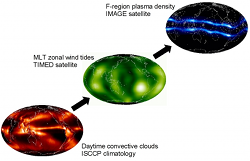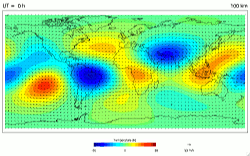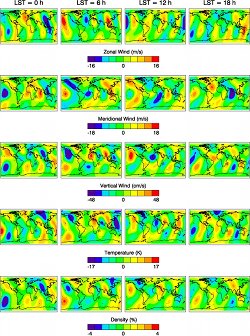
Atmospheric tides due to persistent tropospheric weather systems and their effects on the geospace environment, as observed by NASA's TIMED and IMAGE satellites. Click image for larger figure.

Diurnal and semidiurnal tidal temperature and wind perturbation at 100 km altitude for September 2005 as seen by the TIDI and SABER instruments on board the TIMED satellite. Click image for animation.

Tidal perturbations due to upward propagating nonmigrating diurnal and semidiurnal tides at 250 km from empirical modeling of observed tides in the mesosphere/lower thermosphere. Results are shown as function of longitude, latitude, and local solar time (LST). Migrating tides are not included.Click image for larger figure.

October 2019 colloquium on "The tidal weather of Earth's middle and upper atmosphere". Click image for youtube video.
Dr. Jens Oberheide
Professor
Department of Physics and Astronomy
Spring 2024 Course
Thermodynamics and Statistical Mechanics (PHYS 4650/6650)
TTR 11:00 am - 12:15 pm, Long Hall, Room 228
Weather and Space Weather
The space weather of Earth's upper neutral and ionized atmosphere is strongly influenced by high-latitude energy input due to magnetosphere-ionosphere coupling, and solar radiation variability. Recent observations and model simulations now demonstrate unequivocally that the geospace environment (here: ionosphere-thermosphere-mesosphere, ITM) owes a substantial amount of its variability to waves forced in the lower parts of Earth's atmosphere. An exciting new realization is that persistent tropical rainstorms produce large longitudinal and local time variations in bulk ITM properties: temperature, wind, density, chemical composition, airglow and plasma density, to name a few. Energy and momentum from the troposphere are carried upward by small-scale gravity waves and large-scale non-Sun-synchronous (nonmigrating) atmospheric tides. The result is a vertical coupling over more than 400 km in altitude. Tropospheric weather is hence affecting even regions of Earth's upper atmosphere where the ISS and many satellites are orbiting!
Why is this important?
There is a lot of interesting physics going on, involving dynamics, thermodynamics, chemistry, electrodynamics and their interaction. The induced geospace variability competes with the solar and magnetic driving from above. Consequences for telecommunications, re-entry and satellite operations still need to be explored. The extent to which the effects of this quiescent atmospheric variability are transmitted to the magnetosphere is yet to be resolved. Furthermore, as tides are closely linked to the parameterizations of radiative heating, convection, clouds and latent heat in current general circulation models (including climate models) they provide a sensitive means of evaluating and validating these parameterizations.
Methods used
Atmospheric tides and planetary waves are analyzed in the data from a variety of satellites: TIMED, EOS, CHAMP, TRMM and interpreted using physics-based empirical, mechanistic and first-principles modeling. The results contribute to a wide range of research projects and programs in close collaboration with national and international universities and research centers.
Current projects
FDSS Track 1: Integrating Research and Education in Magnetosphere-Ionosphere-Atmosphere Coupling at Clemson University, PI, NSF award 2347149, 2024-2029.
Exploring Day-to-Day Variability of the Ionosphere-Thermosphere System Driven by Planetary Wave-Tide Interactions, co-I, NASA grant tbd, 2024-2027.
Exploring the response of the ionosphere/thermosphere to the Madden-Julian Oscillation, PI, NASA grant 80NSSC22K1010, 2022-2026.
Collaborative Research: ANSWERS: Impacts of Atmospheric Waves and Geomagnetic Disturbances on Quiet-time and Storm-time Space Weather, co-I, NSF grant 2149695, 2022-2025.
Role of lower atmosphere waves in preconditiong the ionosphere-thermosphere response to geomagnetic storms using ICON and GOLD, co-I, NASA grant 80NSSC22K0018, 2021-2024.
Exploring the causes of water vapor variability in the mesosphere, derived residual mean circulation and implications for the composition of the thermosphere using SABER and GOLD, PI, NASA grant 80NSSC20K1353, 2020-2024.